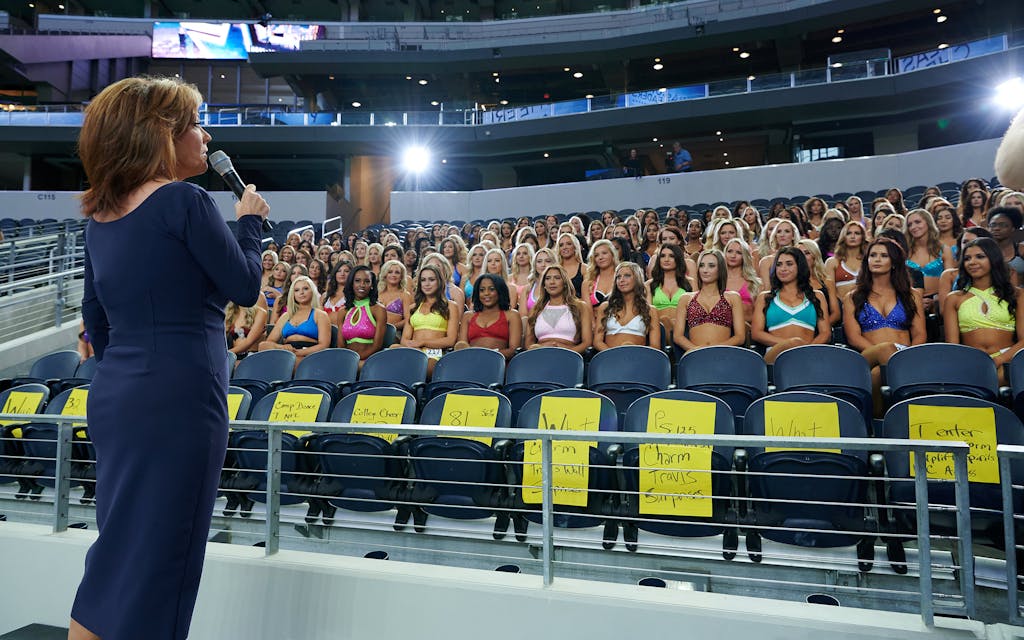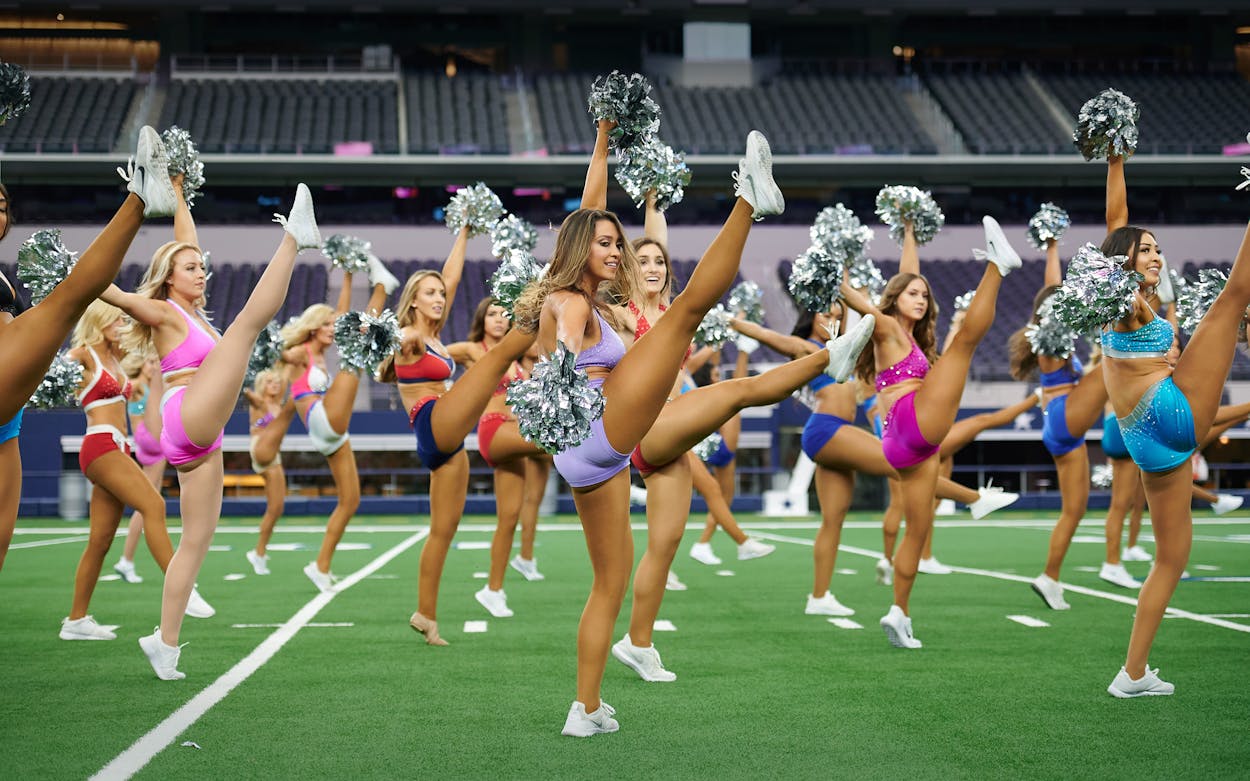“We could never have anticipated the outpouring of admiration and support from our fans and friends over the 16 Seasons on CMT’s Making the Team,” said Cheerleaders Director Kelli Finglass. “We are in the process of negotiating a new partnership and we look forward to continuing to feature the DCC on a new platform.”
Earlier this week, crew members for the long-running reality show Dallas Cowboys Cheerleaders: Making the Team got a text message. The show was not being renewed. Neither the Cowboys organization nor CMT, the cable network that started life as Country Music Television and has aired Making the Team since 2006, has announced the news publicly, but showrunner Peter Zasuly confirmed it. Beyond that, he wasn’t interested in talking. Texting from L.A., where he is based, he wrote, “It’s too recent.”
CMT had long touted Making the Team as its biggest hit. An addictive mix of competition and human drama, much like football itself, Making the Team has served as an unlikely showcase for the talented young dancers aiming for a coveted spot on the sidelines of America’s Team. The episodic series follows candidates from the first day of auditions through a grueling, months-long training camp as their numbers dwindle to the final 36. A cult hit that never quite broke into the mainstream, Making the Team was wildly beloved by its mostly female audience, who took to fan pages on Facebook and Reddit to share observations, gush and gossip about the cheerleaders, and debate the show’s many twists and turns. Back in January, writer Allie Jones wrote an ode to its undiscovered greatness in, of all places, Gawker:
In the dead of winter, it’s important to have a television show to look forward to as you go about your miserable day. For me, that show is a reality program on the Country Music Television network called Dallas Cowboys Cheerleaders: Making the Team. It has been running continuously for the last 16 years — longer than Keeping Up With the Kardashians and The Big Bang Theory. I’m sure it will outlive us all, and yet I’m the only person I know who watches it. I hope that changes today.
The title of that story, “The Best Show You’re Not Watching,” strikes me as eerily prescient, an earnest plea to watch a program that was—unbeknownst to anyone—on its last legs. Sixteen seasons, thousands of gorgeous and talented hopefuls, and countless eliminations later, Making the Team would not see another season on the cable channel where it began.
Longtime cheerleaders’ director Kelli Finglass, whom I messaged through Instagram (where she often sent me messages at late hours), did not respond. A group of veteran cheerleaders was in Puerto Vallarta, Mexico, for the team’s annual swimsuit calendar shoot when the news came down, and it wasn’t clear if they’d heard it. “thankful for @bahimi for the best swimwear EVER,” one of the cheerleaders posted on Instagram on Wednesday, posing in a yellow bikini on a wooden deck flanked by palm trees. “i am completely obsessed with the suits they have sent me! go get you some goodies my friends summer is on its way💕.”
For the Cowboys, however, the week was looking more like the extension of what has been a very long winter. In early February, Cowboys PR executive Rich Dalrymple unceremoniously retired, and a couple weeks later, Pulitzer Prize–winning ESPN reporter Don Van Natta Jr. broke the news of a $2.4 million settlement stemming from a 2015 incident in which four cheerleaders spotted Dalrymple in their dressing room allegedly taking photos or videos of them as they undressed. What he was doing in that dressing room, why he had not been immediately fired (given that the incident came on the heels of another shocking allegation that Dalrymple had taken upskirt photos of Cowboys executive Charlotte Jones, who is team owner Jerry Jones’s daughter), was a riddle to make the Sphinx scratch its chin.
Having spent more than a year working on America’s Girls, a Texas Monthly podcast about the lost history and cultural impact of the Dallas Cowboys Cheerleaders, I had unusual access to the famously insular group, and my phone lit up with messages from former cheerleaders eager to understand what went down and share their frustration, sadness, and/or disgust that a team that repeatedly referred to its cheerleaders as “iconic” and repeatedly told them that the endless rules and behavioral codes by which they lived were for their protection, had continued to employ a man who appeared to so flagrantly disregard their privacy. An internal Cowboys investigation turned up no wrongdoing, and the NFL declined to investigate, but several of the cheerleaders I spoke with weren’t buying the exoneration.
“Every decision I’ve made in my life, I thought about that team,” said Tami Barber, best known as the seventies cheerleader with the pigtails and an unusually outspoken alumna. “Don’t tarnish the star” was a mantra for the cheerleaders’ president, Charlotte Jones, though the sentiment predates her father’s ownership. Legendary director Suzanne Mitchell, whose leadership is often credited for the cheerleaders’ rise to fame in the late seventies, had long instilled the notion that as a cheerleader, you represent the brand—in the way you dress, speak, and behave, on and off the field. Being a cheerleader was the experience of a lifetime for many of the women, including Tami Barber. “Nothing in my life will ever compare to that time,” she told me for the podcast. But Tami was taking a cautious step away from the organization (though she pointed out that she would never step away from the cheerleaders). She was dealing with a cancer diagnosis in New Orleans when I reached her by phone shortly after the scandal in mid-February. “If I were in AT&T Stadium today,” she told me, “I would puke on the star.”

February is generally when crew members on Making the Team get a text message with news regarding the upcoming season. Tryouts are in late spring (May 2–10 this year), and the show shoots through summer, wrapping around the time football season starts—but February came, and no messages arrived. That was strange. It’s possible that CMT was contemplating whether they could spin the Dalrymple scandal for added drama.
But more scandals kept coming. In March, news broke that Jerry Jones allegedly had a baby with a woman named Cynthia Davis, whose daughter, Alex, is now a 25-year-old congressional aide. Alex filed a lawsuit stating she should not be bound by a nondisclosure agreement her mother signed when Alex was a baby, and Jerry Jones asked the court on Monday to throw out that case, alleging that Davis was attempting to extort him.
It’s unclear whether bad press around the voyeurism settlement and the paternity claim against Jones factored into the decision to pull the plug on the reality show. CMT had not responded to an email request for comment by press time. Crew members reached by text were reluctant to speak on the record, owing both to uncertainty about the terms of their nondisclosure agreements and loyalty to their coworkers and the cheerleaders, whom they spoke about with admiration. They described the cheerleaders as extraordinary—talented, kindhearted, generous.
One crew member who would go on the record was Don Merritt Jr., who worked for eight seasons as an art director for Making the Team, though he hadn’t been part of the crew since the 2020 COVID-19 pandemic season. When I asked why the show was so popular, he said, “For a while it had that American Idol thing where you could watch the 40-year-old mother trying out.” Auditions featuring less-talented hopefuls were certainly a part of the show’s early appeal, and one of its little-known effects was to suppress audition numbers, a fact shared by multiple sources I interviewed about the show. The number of women auditioning, fell as low as 150 one season, according to Merritt. That’s quite a decline from the early eighties, when around 2,000 women flocked to Texas Stadium to vie for those 36 spots. The women who did brave the reality show, however, turned out to be next-level dancers. If Making the Team dampened the audition-day hype, it also elevated the talent and made the day of auditions a lot shorter.
Merritt’s observation that the show had an “American Idol thing” is certainly true. Making the Team launched in 2006, the brainchild of writer-producer Eugene Pack, whose many credits included the Miss USA Pageant. This was high tide for reality TV, a genre that exploded around the turn of the century with the debut of Survivor, The Bachelor, and American Idol. Like those zeitgeist shows, Making the Team had built-in dramatic tension: only 36 women would survive (metaphorically). Thrilling competition, tearful eliminations, plot twists drawn from real life (injuries, heartbreaks, personal tragedies) became a part of the narrative.
Unlike shows such as The Real Housewives, Making the Team did not traffic in catfights, and it felt earnest in a way that swept you up into these women’s hopes and dreams. Whether or not the producers were scheming behind the scenes to pump up the ratings (I was told by several crew members they weren’t), the women who made the cut seemed to be chosen because they were deemed the best candidates, not because they would pump up the drama (which ended when they hit the sidelines, after all). Although early seasons contained a certain mean-girl humor and casual body snarking that was endemic in the culture at the time, the show had moved away from that over the past few seasons, and perhaps the most surprising thing about Making the Team was how sweet it could be.
“I used to watch that when I was stoned in college with my friend Susie,” New Yorker writer Jia Tolentino told me for the podcast. “It was the kind of thing where we thought we might be watching it, like, in a snarky, we-will-laugh-at-these-people way, and then we were like, ‘I would f—ing die for these women.’ ”
Many of the crew members were swept up in the hopes and dreams of those women, too. They were a tight-knit group who worked together over many years. Merritt told me about one late night on the job when he spotted two crew members speaking in hushed voices. They looked like they were consoling each other over some bad news. Had a family member died? He waited until it seemed appropriate, then finally asked what was going on. The two crew members looked at him with sadness. Hadn’t he heard? A beloved candidate had been cut.
At one level, Making the Team was only a show, but it was more than that to thousands of fans and many of the folks who made it. The series may still get picked up somewhere else. Crew members I spoke to were hopeful about such a scenario, though I have no idea whether the directive to pull the plug came from CMT or the Cowboys organization. As the show taught those of us who watched: eliminations can be heartbreaking. Very few of us are ready to see a beautiful journey come to an end.
- More About:
- Sports
- Film & TV
- Dallas Cowboys Cheerleaders
- Jerry Jones
- Dallas






